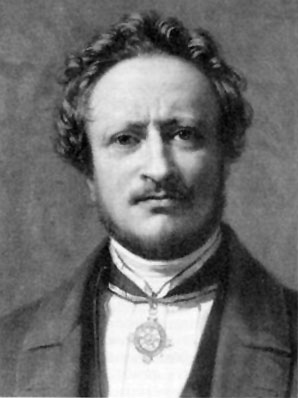File:Johannes Muller.jpg
Johannes_Muller.jpg (298 × 398 pixels, file size: 20 KB, MIME type: image/jpeg)
Johannes Müller (1801-1858)
The German medical scientist Johannes Peter Müller (1801-1858) made important contributions to several branches of medicine, including anatomy, physiology, embryology, and pathology. He was the first to describe the duct that contributes the female internal genital tract and named after him, the "Müllerian duct". The historic terminology is still used, though the current descriptive terminology is the "paramesonephric duct".
- Son of a Koblenz shoe-maker, Müller was born on July 14, 1801.
- Until Müller’s fourteenth year, his region was run by France, and he benefited educationally when the Rhineland passed from French into Prussian hands in 1815.
- At the Koblenz Gymnasium, Müller’s talents for mathematics and classical languages caught the attention of Prussian educational reformer Johannes Schulze, who convinced Müller’s father to send him to the newly founded Bonn University instead of teaching him leather-work.
- Since 1818, Cultural Minister Karl Freiherr vom Stein zum Altenstein (1770-1840) had been working to make the Bonn University a showcase for Prussian Protestant scholarship, particularly in the natural sciences.
- He had preferentially hired Naturphilosophen, scholars who developed theories of nature based on elaborate analogies (Steudel 1963, p. 568; Finkelstein 1996, p. 78).
- Inspired by the philosophy of Friedrich Wilhelm Joseph von Schelling (1775-1854), Naturphilosophen believed that the order of nature corresponded to the structure of human consciousness and tried to discern patterns in natural structures, sometimes classifying animals by aligning them with human sensory systems.
- Müller began studying medicine at the Bonn University in the fall of 1819 and quickly embraced this approach to nature, earning his medical degree in 1822 with a doctoral thesis on the patterns of animal movement, especially in insects.
- Between 1828 and 1830, Müller conducted extensive comparative studies of the endocrine and reproductive systems, publishing De glandularum secernetium and Bildungsgeschichte der Genitalien in 1830. He demonstrated that glands, not blood vessels, secrete substances that control bodily functions, and he identified the blood vessels responsible for male erections.
- Excerpts from: Max Planck Institute for the History of Science, Berlin - Otis, Laura. 2004. Johannes Müller. The Virtual Laboratory (ISSN 1866-4784) Biography | PDF
- Links: 1850 Educational History of the Genitalia | uterus | Genital System Development | menstrual cycle | AMH | Embryology History
| Historic Embryology |
| Johannes Peter Müller (1801 - 1858) in 1830 was the first to describe the female genital duct that develops as the uterus and vagina, historically named after him as the "Müllerian duct". The current terminology is the "paramesonephric duct". |
| Historic Embryology |
| Johannes Peter Müller (1801 - 1858) in 1830 was the first to describe the female genital duct that develops as the uterus and vagina, historically named after him as the "Müllerian duct". The current terminology is the "paramesonephric duct".
Alfred Jost (1916-1991), a French endocrinologist researcher, first discovered in 1947 Anti-Mullerian Hormone he used a rabbit model to identify this hormone as responsible for Müllerian duct (paramesonephric duct) regression during fetal rabbit development. His findings explained several abnormalities of sexual development. This included the "freemartin calf", that acquires AMH from a male twin in utero generating an infertile female with masculinized behavior and non-functioning ovaries. |
References
Über die Larven und die Metamorphose der Ophiuren und Seeigel (1846)
Cite this page: Hill, M.A. (2024, April 23) Embryology Johannes Muller.jpg. Retrieved from https://embryology.med.unsw.edu.au/embryology/index.php/File:Johannes_Muller.jpg
- © Dr Mark Hill 2024, UNSW Embryology ISBN: 978 0 7334 2609 4 - UNSW CRICOS Provider Code No. 00098G
File history
Click on a date/time to view the file as it appeared at that time.
| Date/Time | Thumbnail | Dimensions | User | Comment | |
|---|---|---|---|---|---|
| current | 12:29, 20 June 2011 |  | 298 × 398 (20 KB) | MarkHill (talk | contribs) | ==Johannes Müller (1801-1858)== Category:Historic Embryology |
You cannot overwrite this file.
File usage
The following 16 pages use this file:
- BGDB Sexual Differentiation - Early Embryo
- Book - Educational History of the Genitalia
- Developmental Signals - Anti-Mullerian Hormone
- Embryology History
- Genital System Development
- Germany Statistics
- Historic Embryology Vignette
- History - Embryologists
- M
- Uterus Development
- File:Johannes Muller.jpg
- Template:Anti-Mullerian Hormone Vignette
- Template:Uterus Vignette
- Category:Germany
- Special:Badtitle/NS501:Embryology History
- History:Embryology History


